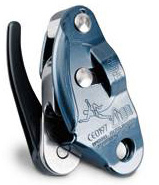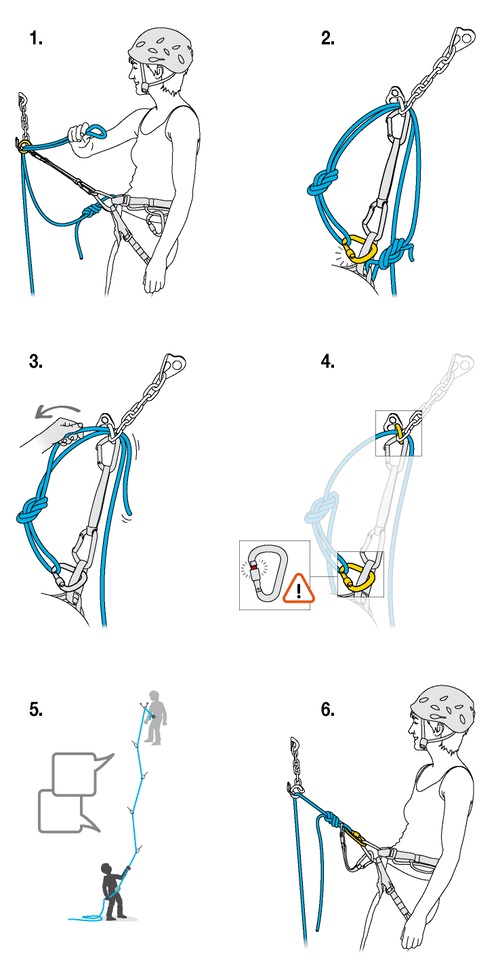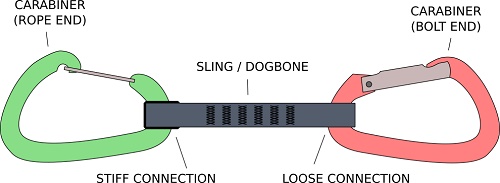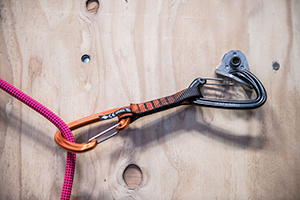Some
Tips on Sport Climbing
Introduction
This represents a small number of tips among a vast
knowledge base you need to lead sport climb and is no means a
substitute for
learning this hands-on with an experienced instructor. Brian Phillips
Lowering/Rappelling and
Top-Roping Off of Top
Anchors ("Cleaning an Anchor")
There are two ways to get down from a single-pitch sport route. One is
to be lowered off the anchor by your belayer and the other is to
rappel. Almost everwhere the accepted and preferred method is to be
lowered by your belayer,as it is safer. Whatever you are going to do
make sure you
communicate that to your belayer. Top-roping off fixed anchors is
prohibited in all areas as it has a sawing effect
that quickly wears out the fixed biners (as shown below). If you are
going to top-rope the climb after the lead then leave draws (as shown
below) that the last person up cleans the draws off the anchor.
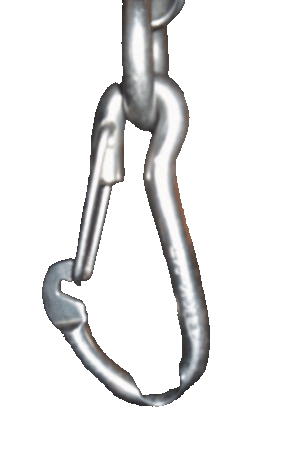


Some
of the anchor chain configurations you will encounter at various crags.
Not all sport climbs are going to equipped with steel carabineers like
an indoor climbing gym. Many top anchors will have closed steel rings,
quicklinks, or chain links. The safest method is to lower
off the
fixed gear. The American Alpine Club (AAC) method (below) is
the
safest.The well intentioned rationale for rapping is usually to avoid
putting wear and tear on the anchors, but the AAC calls this “. . .
misplaced sense of stewardship that seeks to preserve anchor hardware.”
Modern anchor hardware is extremely robust, and ideally meant to be
easily replaced.
1.
The
second climber climbs the route, cleaning gear as needed.
2.
The
second climber arrives at the anchor, the FIRST thing you do is
to clip in with a sling, qickdraw, or PAS
from their belay loop to a solid part of the anchor.
3.
Remaining
on belay, the second pulls up a large bight of rope, and feeds it
through the
anchor hardware meant for lowering.
4.
The
second ties a figure 8 loop onto the bight, and clips it to their belay
loop
with a locking carabiner.
5.
The
second then unties their main tie in knot from their harness, and pulls
the
tail of the rope through the chains.
6.
The
second cleans the leader's draws from the bolts.
7.
The
second calls for tension from the belayer, tests that the system looks
right
and is holding, removes their quickdraw/sling/PAS, and lowers to the
ground.
Sometimes,
you won’t be able to push a bight of rope through the anchor. This
depends on the thickness of your rope and the type of anchor. In this
case, you must use a slightly different method. As with the previous
method you will remain on belay’ during the whole setup.
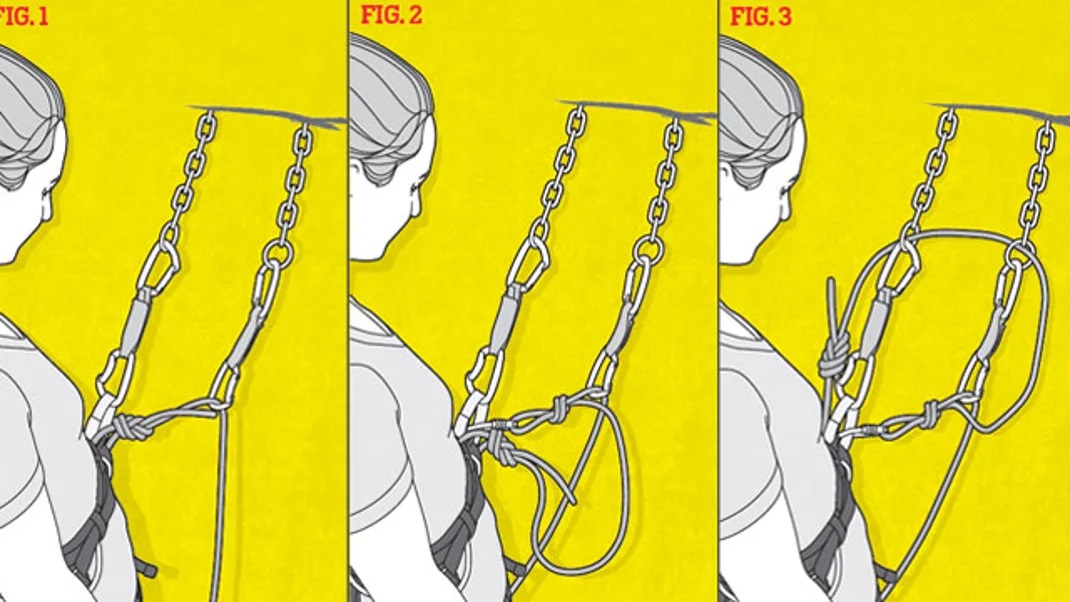
If the anchor has chains and if they are long enough to place draws
that will take the weight of the rope and if the plan is to top-rope
the climb then the
leader can and should set up the top-rope so it can be cleaned with
just removing the draws/biners. For example:

Clipping
Biners

Some methods of
clipping
Back Clipping
Back clipping is a common mistake of inexperienced climbers.
The
rope should always be clipped so it runs from the rock out of
the biner toward the leader.

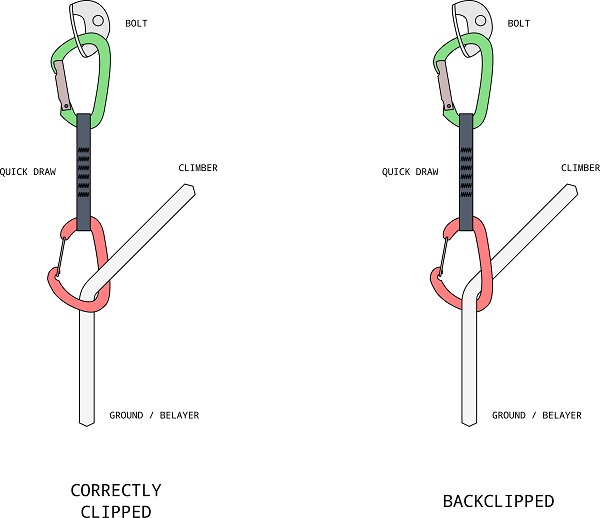
Illustration of how an incorrectly “back clipped” biner can
become
unclipped and how to correctly clip.
Spine Towards the Line
Additionally the biner/rope should always be positioned so
that it will hit the solid axis of the biner versus the gate during a
fall.
This can be is caused by the climber traversing at an angle above
the biner. To avoid this make sure the gate is facing the
opposite direction that you are traversing. Remember to face the spine
of the carabineer towards the line of the route. "Spine
towards
the Line." Even
if there isn't a traverse in the route and you are climbing to
the
right or left of the bolt the spine of the biner should be facing you
so the rope hits the spine and not the gate in a fall. This
is widely
not understood and
misapplied by many experienced sport climbers.

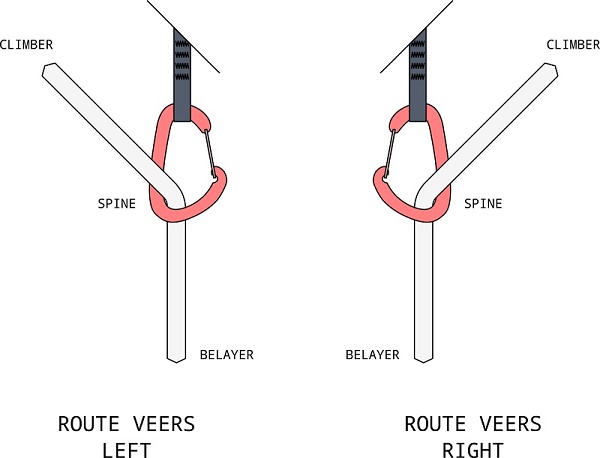
The gate should be facing the opposite direction of the
traverse or to the right or left of the climber to prevent the
potential for unclipping.
Z Clipping
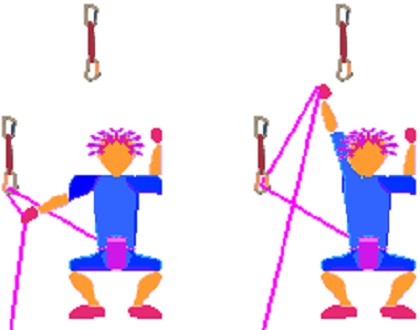
Don't do
this! When the clips
are close together you can mistakenly reach down below your last clip
and clip the rope to the next clip. This is called
Z-clipping. You will notice it immediately with the rope
drag. Usually the easiest way to escape the situation is to
reach
down and unclip the rope from the lower draw.
Clipping At Waist Level
When you clip can be as important as how you clip. If you are below the
first bolt you can reach up as high as you can above your head to clip
the first bolt (if you didn't already clip it with a stick-clip). The
next few bolts should be clipped when they are at waist level instead
of reaching way above your head. You do this to minimize the amount of
slack you have in the rope should you fall when clipping. A full arm
length of rope out near the ground could result in ground fall. All
this is dependent on sound judgement. Sometimes you have a huge jug to
hang off well below the bolt and it is better to clip here than trying
to hold on to a small crimper when the bolt is at waist level.
Rope Mangement
The rope should never be running behind a
leg as this
can cause you to flip upside down in a fall.
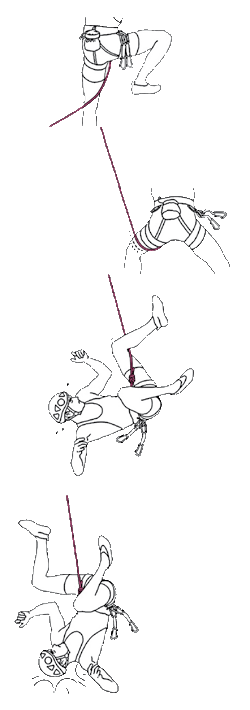
Stopper Knots
If
you are not postively sure of the route length then tie stopper knots
in the end of the rope so you do not accidently lower the leader off
the end of the rope. Some routes are designed for 70 meter ropes.
A
realtively too common accident is sport climbers getting lowered off
the end of the rope because the rope was too short for the climb. This
is particularly common with using gym length ropes outside. Tie a
stopper knot in the end of the belayer side of the rope so that it will
jam in the belay device and this accident can't happen.
Belaying and Providing a
"Soft Catch"
Anchor
the belayer?
Unlike
trad climbing, most of the time sport climbers do not anchor on the
first pitch (ground). This facilitates moving around to be in
the
best position to belay the leader. The only exception is if the leader
outweighs the belayer by a considerable amount. If your belayer is not
anchored you want them belaying close in to the cliff so that, in the
case of a leader fall, they are not dragged off their feet into the
wall dropping you in the process.
A
soft catch is one of the most misunterstood and misapplied techniques
in sport climbing. Many
climbing gyms teach how to give a soft catch and
it is a valuable skill on an overhanging lead wall. However, it only
translates
to the outside on overhanging routes.
A soft catch is where the belayer
has some slack in the rope and/or gives a dynamic catch by jumping or
moving in
toward the wall when the leader falls. The object of a soft catch on an
overhanging route is so that the climber falls straight down (in air)
and does
not swing in to hit the wall spraining/breaking his ankles.
A soft catch should only
be used on overhanging routes or dead vertical routes where there are
no
ledges. The
majority of routes (both sport and trad)
outside are slabby to
vertical. Giving a soft catch on a slabby route will only
increase the
distance that the leader skids down the slab losing skin along the
way.
On a vertical route a soft catch will increase the distance that the
leader
falls and increase the chance that they will catch a foot on a hold or
hit a
ledge and break an ankle. So, unless it is an overhanging route the
shorter the
fall the better. I
have seen many belayers standing ten feet away from the cliff
with a big loop of rope to the leader who is only 15 feet off the
ground. That is not a soft catch. That is ground fall. Dynamic belays
require a lot of practice. If in doubt it is better to keep the rope to
the leader tight than to have it too loose and risk having them hit a
ledge or ground fall. Make sure to stand close to the first bolt
clipped but not directly under the climber. When the climber reaches
the
second or third bolt where he/she
is safe from hitting the ground, then you can step back to watch the
climber from a distance where they are more visible. The best way to
give a soft catch is to wait until the rope comes taut onto the last
clip and then jump. Jumping
will make the fall as gentle as possible.
This requires a lot of practice to do correctly and being an
attentive belayer. Recent studies have shown that having
slack in
the rope does nothing to reduce the arc and swing into the cliff.
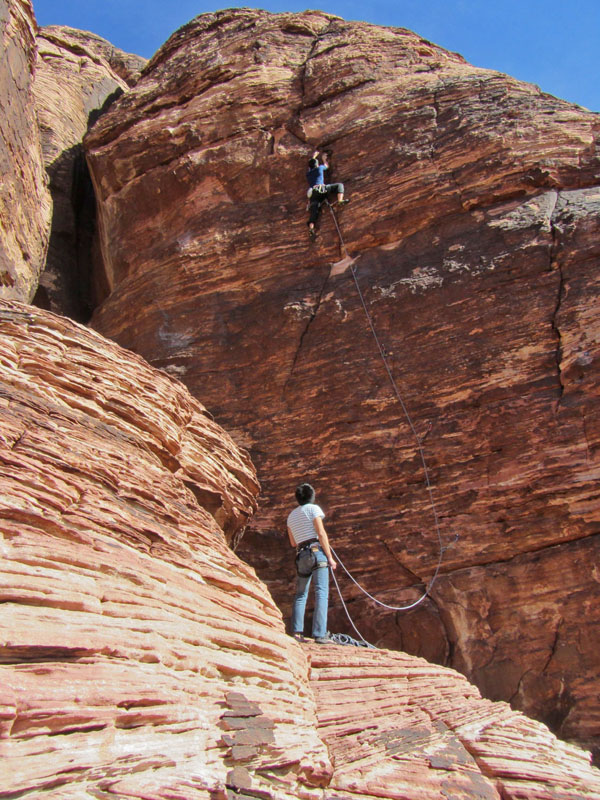
Example of a bad belay with way too much slack in the rope and the
belayer way too far from the wall.
Gear
Draws: Quickdraws are used for sport climbing. They are designed so
that one biner is clipped through the smaller hole and sits tightly on
the draw and one hole is larger allowing the biner to rotate. The
tighter non-rotating biner is always the bottom biner to facilitate
easier clipping and avoid dangerous cross loading on the hanger. Also
by always clipping the same biner to the hanger any rough dings it may
get from repeated falls are on the hanger side and not on the biner
your rope is running through. Many quickdraws come with two different
colored biners to facilitate always clipping the same one and many will
have a bent-gate biner on the bottom for easier clipping.
The
carabiners on quickdraws should face the same direction. All
quickdraw manufacturers (BD, Petzl, Camp, DMM, Mad Rock) orient the
biners this way now. If you have some older draws switch the
biners around. Black Diamond did studies
that show how a draw can come unclipped from the hanger with opposing
biners on a draw.
If you are primarily a trad climber with a bunch of two foot
runners
they can be shortened to the length of a quick draw for sport climbing.
However, they are not as good as a quickdraw as they tend to flop
around and can orient the biner the wrong way. Sport climbers
should carry a one or two of these to extend under an overhang to
reduce rope drag.

Method used to shorten 2 ft sling to make a “quickdraw.”
Belay Devices
In sport climbing an assisted braking belay device such as a
Petzl
GriGri is what every climber should learn to use competently.
In
multiple studies assisted braking belay devices have been shown to be
considerably safer than a tube
style device like an ATC.
